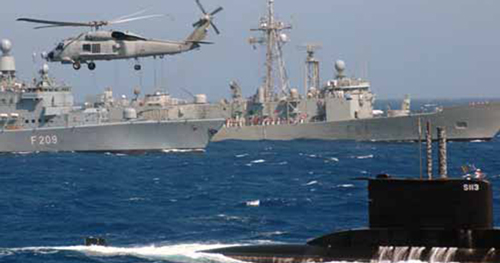By Harry Syringas (Sldinfo research staff)
**@*****fo.com
According to the Assembly of the Western European Union’s assessment on the risks and threats of the maritime situation in Europe, among the maritime nations of the European Union, coastal regions account for over 40% of Europe’s GDP while roughly 90 % of the EU’s foreign trade and over 40% of the internal trade travels by water. Europe is a continent where maritime transportation is crucial and directly involves countries from the North to the South of Europe. Maritime security is indeed increasingly important in the scheme of things for European governments. The challenges of dealing with piracy, to protect against environmental challenges, to prepare to deal with Arctic challenges, and to provide for the security of the global conveyer belt of goods are among the priorities. Growing interest has not lead yet to crafting a system of sharing data and information to shape common policies, procedures and concepts of operations. But there are attempts to shape more effective efforts to build such a foundation for a coordinated approach.
An example of growing interest in shared collaboration for maritime security is the Adriatic-Ionian initiative (AII).

Origins of the AII
Part of the Mediterranean Sea is the Adriatic – Ionian basin, an area between Italy and Greece, reaching also the coasts of Albania, Croatia, Slovenia and Montenegro. The Adriatic-Ionian Initiative (AII) was initiated by Italy. Practically, this is a follow-on activity (in military sense) of the Ancona Declaration – Conference on Development and Security in the Adriatic and Ionian, held in Ancona in May 2000. This initiative is a forum which joins naval components from Italy, Greece, Slovenia, Albania, Croatia, Serbia, Montenegro and Bosnia and Herzegovina, with an aim to promote cooperation, joint training and conduct of exercises and exchange of experiences between the Adriatic and Ionian Sea navies.
The Italian and Greek Navies are in charge of developing a naval project for the navies of the seven member states with a view to facilitating surveillance of the Adriatic-Ionian region. In June 2009, the initiative was consolidated by the creation of a permanent Secretariat.
A Broad Agenda
The AII follows the outline of the Stability Pact, even if some of the participants are not members of the EU. In the framework of the Table on Environmental Protection and Sustainable Development a document called the Adriatic Action Plan (AAP) 2020 was adopted at the environmental ministers’ meeting in June 2003 in Zadar, Croatia.
The AII is also a step for its non EU members, all at different stages of accession, closer to the standards of the European institutions as they get the chance to exchange experiences and participate in common projects with three EU full members (Italy, Greece and Slovenia).
The Council is chaired on a rotating basis by the eight member countries. Foreign Ministers of the member states form the decision-making body of the AII and the agenda is set up by the meetings of the National Coordinators. Its parliamentary dimension is “sealed” by the annual meeting held by each presidency and joined by national parliamentarians. Moreover, during each presidency, meetings with the Heads of the Naval Forces are being organized in order to discuss recent updates and issues concerning the Initiative as well as exercises in which all fleets take part; for instance, in March 2009, in Athens, the Greek Head of the Naval Forces, invited his counterparts from Italy, Albania, Montenegro and Croatia to confer and exchange ideas on the exercise ADRION – CAX 2009.
Speaking of an initiative bearing the name of two seas – some consider it to be one – the navies of the countries involved play a main part and are being primarily used for civilian purposes. The agenda includes combating illegal activities, environmental protection, sustainable energy, tourism, maritime transport, education and inter-university cooperation. However, the first pillar of this initiative relates to security and the fight against crime in the region. In times of peace, the Army’s task is to prevent a conflict before it occurs. Illegal trafficking and migration is very high on the list of activities. So are environmental issues and access to energy sources. In relation to the latter, three projects are covering the environmental aspect of the AII. The projects initially link three North Adriatic AII member states that are more advanced institutionally; other states have agreed to join and follow the projects in their extended phases or to learn from them in following years: navies of the countries around the Adriatic-Ionian basin are hence being used in a constructive way.
***
See for additional information:
Adriatic Sea Partnership: http://asp.rec.org/
Croatian Ministry of Foreign Affairs and European Integration: www.mvpei.hr
Italian Ministry of Defence, Army Navy: www.marina.difesa.it
Secretariat for Adriatic Area: www.seadriatic.net
Hellenic Ministry of Foreign Affairs: www.mfa.gr
Assembly of the Western European Union: www.assembly-weu.org
———-
***Posted February 8th, 2010


